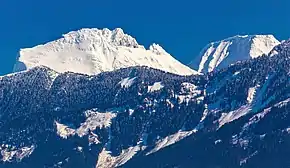| Knight Peak | |
|---|---|
 Southwest aspect | |
| Highest point | |
| Elevation | 2,235 m (7,333 ft)[1] |
| Prominence | 195 m (640 ft)[1] |
| Parent peak | Baby Munday Peak (2,250 m)[2] |
| Isolation | 0.72 km (0.45 mi)[1] |
| Listing | Mountains of British Columbia |
| Coordinates | 49°10′07″N 121°38′16″W / 49.16861°N 121.63778°W[3] |
| Naming | |
| Etymology | Ebe B. Knight |
| Geography | |
 Knight Peak Location in British Columbia  Knight Peak Knight Peak (Canada) | |
| Country | Canada |
| Province | British Columbia |
| District | Yale Division Yale Land District[4] |
| Parent range | Cascade Range North Cascades Cheam Range |
| Topo map | NTS 92H4 Chilliwack[3] |
| Geology | |
| Mountain type | Fault block |
| Climbing | |
| First ascent | 1892 |
Knight Peak is a 2,235-meter-elevation (7,333-foot) mountain summit located in the Cheam Range of British Columbia, Canada.[4]
Description
Knight Peak is situated 21 kilometers (13 miles) east of Chilliwack and 4 km (2.5 mi) south of the southern tip of Wahleach Lake. Knight Peak is more notable for its steep rise above local terrain than for its absolute elevation. Topographic relief is significant as the south aspect rises over 1,000 meters (3,300 feet) above Airplane Creek in 1.5 km (0.93 mi), and the north aspect rises 1,500 meters (4,900 feet) in two kilometers (1.2 miles). Precipitation runoff from this mountain drains south to the Chilliwack River via Airplane and Foley creeks, and north to the Fraser River via Wahleach Lake and Wahleach Creek. The nearest higher neighbor is Baby Munday Peak, 0.72 km (0 mi) to the east.[1]
History
The first ascent of the summit was made in September 1892 by Ebe B. Knight and David Walker.[5] Don Serl and Bruce Kay first climbed the northwest face in April 1987.[5]
The peak was likely named after Ebe R. Knight who made the first ascent and was a leading spirit in various ascents in this area during 1888–1892.[4] He also made first ascents of Cheam Peak, Stewart Peak and Lady Peak.[5] The toponym was officially adopted May 30, 1946, by the Geographical Names Board of Canada.[3]
Climate
Knight Peak is located in the marine west coast climate zone of western North America.[5] Most weather fronts originate in the Pacific Ocean, and travel northeast toward the Cascade Mountains. As fronts approach the North Cascades, they are forced upward by the peaks (Orographic lift), causing them to drop their moisture in the form of rain or snowfall onto the Cascades. As a result, the west side of the North Cascades experiences high precipitation, especially during the winter months in the form of snowfall.[5] Because of maritime influence, snow tends to be wet and heavy, resulting in high avalanche danger.[5] Temperatures in winter can drop below −20 °C with wind chill factors below −30 °C. This climate supports a small glacier in the cirque northeast of the peak. During winter months, weather is usually cloudy, but due to high pressure systems over the Pacific Ocean that intensify during summer months, there is often little or no cloud cover during the summer.[5] The months July through September offer the most favorable weather for viewing or climbing this peak.
Geology
The North Cascades feature some of the most rugged topography in the Cascade Range with craggy peaks, ridges, and deep glacial valleys. Geological events occurring many years ago created the diverse topography and drastic elevation changes over the Cascade Range leading to various climate differences.
The history of the formation of the Cascade Mountains dates back millions of years ago to the late Eocene Epoch.[6] With the North American Plate overriding the Pacific Plate, episodes of volcanic igneous activity persisted.[6] In addition, small fragments of the oceanic and continental lithosphere called terranes created the North Cascades about 50 million years ago.[6]
During the Pleistocene period dating back over two million years ago, glaciation advancing and retreating repeatedly scoured the landscape leaving deposits of rock debris.[6] The U-shaped cross section of the river valleys is a result of recent glaciation. Uplift and faulting in combination with glaciation have been the dominant processes which have created the tall peaks and deep valleys of the North Cascades area.
See also
Gallery
References
- 1 2 3 4 "Knight Peak, British Columbia". Peakbagger.com. Retrieved 2022-11-22.
- ↑ "Knight Peak, Peakvisor.com". Retrieved November 22, 2022.
- 1 2 3 "Knight Peak". Geographical Names Data Base. Natural Resources Canada. Retrieved 2022-11-22.
- 1 2 3 "Knight Peak". BC Geographical Names. Retrieved 2022-11-22.
- 1 2 3 4 5 6 7 Beckey, Fred W. (2008). Cascade Alpine Guide (3rd ed.). Mountaineers Books.
- 1 2 3 4 Kruckeberg, Arthur (1991). The Natural History of Puget Sound Country. University of Washington Press.
External links
- Knight Peak: Weather Forecast
- Northwest Face (photo): Flickr



